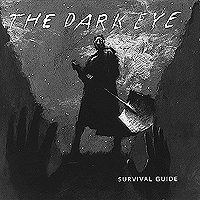By Michael Eilers
Arizona Daily Wildcat
January 11, 1996

By Michael Eilers
Arizona Daily Wildcat
January 11, 1996

A few weeks ago I reviewed a CD-ROM title by Inscape that marked them as one of the emerging masters of this genre, creating distinctive, unique titles. The Dark Eye, a horrifying narrative set in a Victorian mansion, is yet another impressive release.
The premise is very simple: you are a guest at your uncle's house, where a bit of intrigue is taking place between your brother and a young female cousin. As you explore the extremely Gothic Victorian mansion, you fade in and out of reality, visiting drea m-worlds and discovering repressed memories.
Each of these worlds happens to be "inside" a short story by Edgar Allan Poe. From "The Tell-Tale Heart" to "The Cask of Amontillado," you get to travel through several of Poe's classic tales of horror and dread from the narrator's point of view for from t he victim's. You may be the one sealing the crypt at the end of "Amontillado," or the one being sealed in: the choice is yours.
Between these trips to the dark side are mini-episodes of narration and encounters with other characters, such as your uncle. Cunningly narrated by William S. Burroughs, famed author of Naked Lunch, Uncle Edwin is a slightly-insane patriarch who creates v ery disturbing paintings and rules the household with an iron fist. The characters of your brother Edward and your cousin act out their parts in the intrigue, as well as triggering certain flashbacks and events for your own character.
The 3-D environment itself is well-rendered, though most viewers will find it a little sparse. The rooms change as the story progresses, with more and more of Uncle Edwin's mad paintings appearing in the corners. Certain areas of the house are off limits until parts of the story have progressed appropriately, and some rooms cannot be visited at all, a sad acknowledgment of the limitations of the medium.
An especially unique touch is the use of stop-motion animated figures as the principal characters. Doug Beswick, animator for the films Beetlejuice and Aliens, carefully manipulated the figures, who interact with the 3-D environment in a realistic manner. Their gray, unmoving faces allow the narrators to convey emotion and expression, leaving much to the imagination, a similar experience to reading fiction: you must mentally construct faces and mannerisms to match the characters. The stop-motion animation , with all of its inherent flaws and weaknesses, give the action a hand-crafted feel that goes a long way towards helping the viewer forget they are staring at a computer screen.
Somewhat falsely billed as an "adventure," the game progresses in a fairly linear fashion, with time stopping at points until you complete certain actions, or return to a particular room. Rather than being an impediment, this helps to engross you in the s tory, as each plot development depends upon your actions. Like any good novel, each event builds suspense and deepens the plot, as well as adding to the depth of the characters.
Moving from place to place is fairly straightforward, with a spooky, beautifully animated disembodied hand as your cursor. The hand assumes certain postures to indicate where you can go and which objects you can use. Transitions from one location to the n ext are fairly swift, and there is only a brief pause before a movie loads, creating a fairly seamless environment. Sound is used to its fullest extent, from the echoing footsteps of your character to the creaks and groans of the old rooms you walk throug h. Thomas Dolby's production company Headspace created the sonic environments for the game, and the results are eerie, realistic, and extremely crisp, including some of the best creaky-door sounds I have ever heard. The voice narrations are sharp and well -acted at all points. Groaning violins and cellos accompany the tense moments of the narrative, giving the production the feel of a classic horror film.
Unfortunately, the hardware demands are very steep. For this title they recommend an 030 Macintosh or 486 Windows PC, 8 megabytes of RAM, and 16-bit color (thousands) is required. While this video depth is a standard feature on all recent Macintoshes, it is rare on home computers overall, and this may exclude a lot of potential users. The reason behind this requirement is obvious, as it allows the beautifully-crafted movie sequences to display smoothly and clearly. I was able to get the game to run in 256 colors, but the display suffered noticeably in this mode.
This is a work of interactive fiction, rather than an adventure game. The "clues" that make the story progress are fairly obvious, and each story progresses in a linear manner. However, this doesn't in any way limit the experience in fact, it augments and enhances what people have already found to be engrossing and addictive for years: reading Poe's fiction.
The Dark Eye is a return to the format that began all of our travels into the imagination- the novel. It successfully blends the technological advances of the computer with the craft of a storyteller, and the result is a very spooky experience indeed. Buy this disc, a night light, and check a book of Poe stories out of the library. Lovers of Poe will find this a remarkable experience, while those new to the grand master of horror will encounter his fiction from the inside a unique experience, crafted by the some of the masters of the medium.
The Dark Eye is available at most computer stores: call 1-800-MY-DEALER to find a store near you. Check out Inscape's web page at http://pathfinder.com/inscape or e-mail them at inform@inscape.com.






